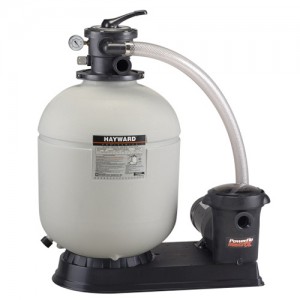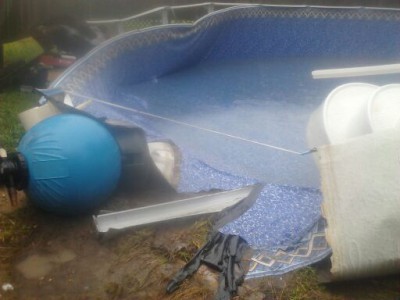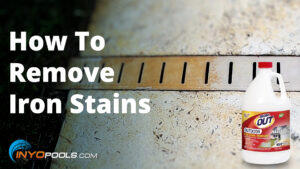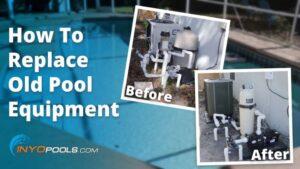I have really good news and really bad news when it comes to having a leak in an above ground swimming pool. The really good news is that once you find the leak, it’s usually super easy to repair. The bad news is (yeah, you probably guessed it) finding the leak is difficult. Locating a leak in an above ground is so difficult that I don’t offer it as part of my services. Even if it’s the off-season and I’m broke, I’ll turn down a job to detect a leak. There are many cases where the leak is never found in an above ground and the only solution is to replace the entire liner. So now that I’ve scared you and lowered your expectations, let me give you some instruction on how to find a leak.
Check the Pool’s Equipment First
To check the pool’s equipment first is the easiest. When looking for a leak in an above ground pool, the hardest place to find it is somewhere in the vinyl liner. To avoid any frustration, inspect the equipment first (even if you have a feeling that the leak is inside the pool). Follow this checklist first. The leak may be outside the pool.
- Clean the equipment area

If the pump/filter area is cluttered or overgrown, clean it first. Pull out all the weeds and store the pool toys, outdoor items and rocks/mulch away from the equipment. If there is an ant pile that formed under the pump, kill the ants and clean area. - Turn on the pump
Some leaks will leak more when the pump is on. Since it is easier to see a bigger leak, you’ll want the pump on. - Inspect the general area for signs of wetness
Water is wet. Duh! So it stands to reason that any signs of wetness are your best signs for a leak. - Look closely at everything
When I say closely, I mean get down on your hands and knees and look at all the components, hoses, fittings, and lids for drips. Sneaky leak alert: Pay close attention to the area directly underneath the pool’s pump. Pumps have shaft seals that can leak straight down into the ground and sometimes there will be no visible ground moisture.Have a dry towel handy in case something is questionable. Wipe the area dry and inspect for any new signs of wetness to appear. - Inspect the skimmer and return at the wall
The pool’s skimmer box and return are two common spots for leaks. Water travels downward due to gravity. Duh #2! Because of this, look directly under the skimmer box and return as that is where the leaking water will travel. If you are not sure, again use the towel to dry the pool’s wall and reinspect for any signs of newly formed moisture.Don’t be in a hurry; take your time. Some leaks are deceiving and require patience to find. If you’ve checked out all these spots and have come up dry, it’s time for the real fun.
Tips for Finding a Leak Somewhere in the Vinyl Liner
This may not be an easy task. The best piece of advice I can give here is to be patient. A leak can be anywhere inside the pool and there is not one soul on the planet that can find some of these so don’t be too hard on yourself if you don’t find it quickly. Here’s what I do listed from first to last:
- Turn off the pool pump and let the water get completely stillYou’ll need to be able to see the bottom of the pool as clearly as possible while you are standing outside of the pool.

I think I found the leak
- While you are standing outside the pool, inspect the pool’s bottom all the way around
Most above ground pools have sand or earth based bottoms and coving. When there is a leak in the vinyl, the water usually leaks out in the ground somewhere underneath the pool. In most cases (but certainly not all) the leaked water travels through the sand/earth bottom and causes the earth to wash away leaving small valleys or divots or holes in the pool’s bottom that was once flat. Some of these washed away areas under the pool are visible and will tell you where the leak is in the liner. If you see something like this, it’s time to get in the pool (SEE STEP 5).
- Check the outside of the pool
Didn’t see anything while you were following the previous step? OK, then while you are still outside the pool, you better check the outside bottom of the pool. If it’s covered, dig around the wall at the bottom and expose the bottom track. This is the tracking that the pool wall fits into at the bottom. Clear away any mulch or rocks or dirt so you can easily see if there are any signs of excessive wetness next to the track.What makes this tricky is that your ground may hold moisture naturally so just because you find some wet ground doesn’t mean it’s a sign that there is a leak in that area. Look for signs of excessive wetness close to the pool as a sign for a leak. - Time to get in, but first clean the pool
Before you consider getting in the pool to find a leak, clean and vacuum it. You are looking for a small hole in the liner so dirt and leaves sitting on the bottom will make it tougher to find. Make sure the water quailty is good too. Swimming in a slimy, cloudy pool sucks. Have a good dive mask or goggles and some kind of applicator that is filled with a food coloring or dye. Also, it would be really nice if you have a diver’s weight belt to keep you down in the water. Again, before you get in make sure the pool pump is off. - Get up-close and personal
A hole can be anywhere in the liner, but most of the time the hole is at the bottom close to the pool’s wall. Put on your mask, take a breath, and swim to the bottom getting up-close and personal with the liner. Closely inspect any of those small valleys or divots you saw earlier for small holes. If you see what may be a hole, shoot some of the dye you have from your applicator around the area and see if the dyed water draws into the hole. If it does, voila, you have found a leak.
So you checked at the bottom of the pool all the questionable areas of the pool liner and found no hole. The next place to check is all the way around the pool where the wall meets the pool’s bottom in the same up-close, methodical manner. Still no leak? Now in the same way check the pool wall starting at the bottom and moving towards the top. Most wall leaks are lower so spend most of the time at the foot at the bottom of the wall.
If you still haven’t found the leak, it’s time to play manta ray. Very slowly swim very close along the bottom (like a manta ray) inspecting every square inch of the pool liner. If at any time you see something that may be a hole, shoot some dye in the area and see if the dyed water draws into it in order to verify the leak.
Now you’re over this. You’ve searched the pool’s bottom like a sand shark for a couple of hours and you look like a prune and didn’t find anything. Well, that sucks! I really feel your pain. The last thing you can do is allow the pool to drain without adding water. It will stop at the point of the leak and make it easier to find, but not always. At this point it may be time to get a new liner. I’d say if your liner is five-years-old or older, then go ahead and get a new liner. When liners age, they may start leaking in several spots as they become brittle.
The last thing I can offer you is good luck finding the leak. Sometimes that’s what it takes.












Leave a Reply